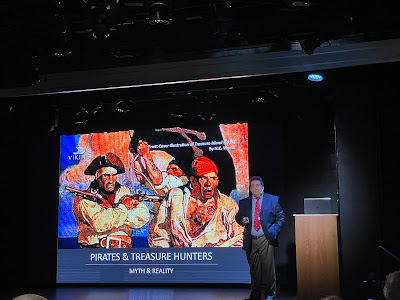Wednesday, December 22, 2021
Ya Mon - Jamaica
Monday, December 20, 2021
Panama Canal
Shari is modeling part of a specialty dinner we had very recently. The theme was Cuisine From Great Britain. She was interested due to the beer battered fish and chips, while I wanted to finally taste a Yorkshire pudding. In the lower left on her plate is the 'pudding' which was more like an air filled muffin with a few bacon pieces. It was a bit of let down, but the slow cooked brisket and veggies were excellent. The round white thing with green specks is chive butter.
Our cruise is partially named after the Panama Canal for good reason. It is the only multi-day stop on the cruise and it was an amazing achievement with incredible importance back when it was built over a hundred years ago and still today.
We were unaware that prior to the United States commitment to build a canal to connect the Atlantic and Pacific oceans, the French had started construction of a canal that would be much like the Suez Canal which they had built in 1869.
Sunday, December 19, 2021
Between North and South America
If you want to see a bigger version of any picture, double click on the picture.
Our Viking Star managed to handle very rough seas on our way from Costa Rica to Colon, Panama. Thankfully, Shari slept through the constant creaking of the ship and the ship's hull slamming against rough water. Wouldn't you know it, we woke to calm seas. Some passengers who didn't sleep through it, or sleep at all, swore they were on the Titanic instead of the Viking Star.
We took the land tour via bus to the western end of the canal, which took us to Panama City, commonly known here as little Miami. Our cruise takes us only partially through the Panama Canal thus our interest in the bus tour.
Saturday, December 18, 2021
Inhabitants of the Rain Forest - Costa Rica
If you want to see a bigger version of any picture, double click on the picture.
We wake each morning wondering if it will be raining in the rain forest. If we considered rain as a curse, we'd be in Costa Rica in October or March or April, it's three dry months. Rain is a small nuisance at worst.
Thursday, December 16, 2021
The Rain Forest and Pirates
Our Viking Star stopped at the island of Roatan, Honduras. If you are not much into geography, Honduras is another small country in Central America. The island is made up of a beautiful coastline and a rainforest. Some passengers complained about rain today, but, we took it in stride. You can't call something a rain forest if it doesn't rain fairly frequently. When we got off the tender that took us to shore, this was the first view - the clouds seemed to promise rain.
We didn't have to go far to be in the rain forest and on a guided walk through what some would call a jungle.
I would have loved the jungle sounds you hear in Tarzan movies but was thankful there were no large snakes or crocodiles. Instead, we saw only the flora of the rain forest like the walking palm trees.
Those tan appendages coming off at an angle from the palm tree are roots, not branches, and that black mass adjacent to the base of the tree is a termite nest.
What caught my attention was all the beautiful flowers in their native habitat instead of a nursery. The Bird of Paradise seems more spectacular in the wild.
Lots of edibles and things we drink or add to food come from the rain forest: coffee, cacao (that makes chocolate), cinnamon, bananas, and cashews to name a few that we saw close up.
There were termite nests in a lot of different trees. BTW, termites are not parasites that attack their live host. They are only harmful to dead wood, like in peoples' houses.
Most of our land tours take place over the course of a morning, sometimes a bit longer. Viking ship activities do not include bingo, gambling, water slides, roller coasters, or formal dress up nights. What they have instead are talks about things unique and interesting about the places you are visiting. One of my favorites was about Caribbean pirates.
Wednesday, December 15, 2021
Belize - the Country
We get to visit several Mayan ruins as we move from country to country. We are in Belize which became Belize in 1981 when the Brits gave in to the locals demand for independence. When I was going to high school over 50 years ago, the country was called British Honduras.




















































